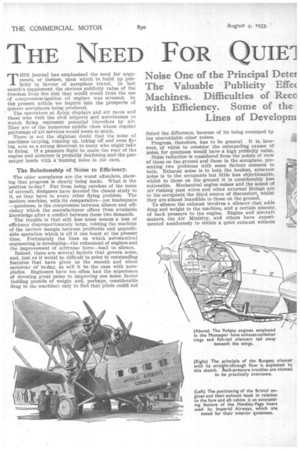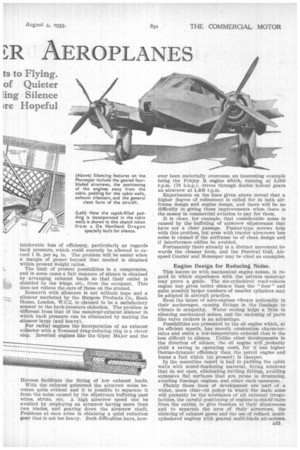THE
Page 42

Page 43

If you've noticed an error in this article please click here to report it so we can fix it.
NEED FOR AE OPLANES
THIS journal has emphasized the need for arguments, or themes, upon which to build up publicity in favour of aeroplane travel. In last month's supplement the obvious publicity value of the freedom from fire risk that would result from the use of compression-ignition oil engines was stressed. In the present article we inquire into the prospects of
quieter aeroplanes being produced. _ The spectators at flying displays and air races and those who visit the civil airports and aerodromes to watch flying represent potential travellers by air. They are of the numerous middle class whose regular patronage of air services would mean so much.
There is not the slightest doubt that the noise of machines taxying, running up, taking off and even flying, acts as a strong deterrent to many who might take to flying. If a pleasure flight be made tile roar of the engine and airscrew is probably deafening and the pastenger lands with a buzzing noise in the ears.
The Relationship of Noise to Efficiency.
The older aeroplanes are the worst offenders, showing that progress is clearly being made. What is the position to-day ? Far from being careless of the noise of aircraft, designers have devoted the closest study to it, as they have to every other flying problem. The modern machine, with its comparative—yet inadequate —quietness, is the compromise between silence and efficiency, which the manufacturer offers from available knowledge after a conflict between these two demands.
The trouble is that still less noise means a loss of efficiency disproportionately large, robbing the machine of the narrow margin between profitable and unprofitable operation which is all it can boast at the present time. Fortunately the lines on which aeronautical engineering is developing—the refinement of engines and the improvement of airframe form—lead to silence.
Indeed, there are several factors that govern noise, and, just as it would be difficult to point to outstanding features that have given us the smooth and silent motorcar of' to-day, so will it be the case with aeroplanes. Engineers have too often had the experience of devoting great pains to improving one noise factor (adding pounds of weight and, perhaps, considerable drag to thf, machine) only to find that pilots could not
defect the difference, because of its being swamped by the unavoidable other noises.
Progress, therefore, has to be general. It is, however, of value to consider the outstanding causes of noise, for quietness would have a high publicity value. Noise reduction is considered from the points of view of those on the ground and those in the aeroplane, presenting two problems with some factors common to both. Exhaust noise is to both the loudest, airscrew noise is to the occupants but little less objectionable, whilst to those on the ground it is considerably less noticeable. Mechanical engine noises and the sound of air rushing past wires and other external fittings are to the occupants the third source of discomfort, whilst they are almost inaudible to those on the ground.
To silence the exhaust involves a silencer that adds drag and weight to the machine, and a certain amount of back pressure to the engine. Engine and aircraft makers, the Air Ministry, and others have experimented assiduously to obtain a quiet exhaust without
intolerable loss of efficiency, particularly as regards back pressure, which could scarcely be allowed to exceed 1 lb. per sq. in. The problem will be easier when a margin of power beyond that needed is obtained within present weight ratios.
The limit of present possibilities is a compromise, and in some cases a fair measure of silence is obtained by arranging exhaust leads so that their outlet is shielded by the wings, etc., from the occupant. This does not relieve the ears of those on the ground.
Research with silencers is not without hope and a silencer marketed by the Burgess Products Co., Bush House, London, W.C.2, is claimed to be a satisfactory answer to the back-pressure objection. The problem is different from that of the motorcar-exhaust silencer in which back pressure can be eliminated by making the silencer large (and heavy).
For radial engines the incorporation of an exhaust collector with a Townend drag-reducing ring is a clever step. Inverted engines like the Gipsy Major and the Hermes facilitate the fitting of low exhaust leads.
With the exhaust quietened the airscrew noise becomes quite evident and it is possible to separate it from the noise caused by the slipstream buffeting past wires, struts, etc. A. high airscrew speed can be avoided by employing an airscrew having more than two blades, and gearing down the airscrew shaft. Problems at once arise in obtaining a quiet reduction gear that is not too heavy. Such difficulties have, how ever been materially overcome, an interesting example being the Pobjoy R engine which, running at 3,000 r.p.m. (78 b.h.p.), drives through double helical gears an airscrew at 1,403 r.p.m.
Experiments on the lines given above reveal that a higher degree of refinement is called for in both airframe design and engine design, and there will be no difficulty in giving these improvements when there is the money in commercial aviation to pay for them.
It is clear, for example, that considerable noise is caused by the buffeting of airscrew slipstreams that have not a clear passage. Pusher-type screws help with this problem, but even with tractor airscrews less noise is caused if the airframe be of clean design and if interference eddies be avoided.
Fortunately there already is a distinct movement towards the cleaner form, and the Percival Gull, Airspeed Courier and Monospar may be cited as examples.
Engine Design for Reducing Noise.
This leaves us with mechanical engine noises, in regard to which experience with the private motorcar may prove a guide. The six-cylindered road-vehicle engine has given better silence than the "four" and quite possibly larger numbers of smaller cylinders may be adopted in aircraft practice.
Even the latest of acre-engines vibrate noticeably in their anchorages, causing fittings in the fuselage to vibrate in sympathy. Water cooling helps a little in silencing mechanical noises, and the enclosing of parts like valve rockers is an advantage.
Possibilities are presented by the oil engine which, at its efficient speeds, has smooth combustion characteristics and emits a low-temperature exhaust that is the less difficult to silence. Unlike other developments in the direction of silence, the oil engine will ,probably yield a saving in operating costs, for it has higher thermo-dynamic efficiency than the petrol engine and burns a fuel which (at present) is cheaper.
In the meantime resort is had to padding the cabin walls with sound-deadening material, fitting windows that do not open, eliminating rattling fittings, avoiding extensive flat surfaces that are prone to drumming, avoiding fuselage engines, and other such measures.
Plainly these lines of development are part of a wider, more clear-cut policy in which the main aims will probably be the avoidance of all external irregularities, the careful positioning of engines to shield them from the cabins, to give freedom to their slipstreams and to separate the arcs of their airscrews, the silencing of exhaust gases and the use of refined, multicylindered engines with geared multi-blade air-screws.




















































































